Psycho
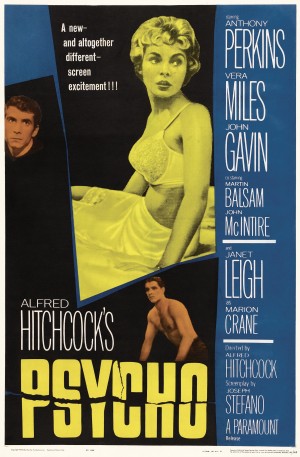 The success of Psycho and its enduring reputation has far exceeded any expectations its makers could have had of it. Shot in five weeks, mostly on the Paramount backlot, with a television crew and a cheap but reliable cast, it could not have been more different from the lavish and expensive production that the director had delivered to MGM earlier in the same year. Based on a novel by Robert Bloch (in turn inspired by the real life cannibal crimes of Ed Gein), it married film noir with Gothic horror and, with the new decade, ushered in an increasingly graphic representation of screen violence.
The success of Psycho and its enduring reputation has far exceeded any expectations its makers could have had of it. Shot in five weeks, mostly on the Paramount backlot, with a television crew and a cheap but reliable cast, it could not have been more different from the lavish and expensive production that the director had delivered to MGM earlier in the same year. Based on a novel by Robert Bloch (in turn inspired by the real life cannibal crimes of Ed Gein), it married film noir with Gothic horror and, with the new decade, ushered in an increasingly graphic representation of screen violence.
Its story – a young woman steals $40,000 dollars from her employer and takes refuge in an isolated motel where she herself becomes the victim of a far worse crime – was a masterly exercise in misdirection. Screenwriter Joseph Stefano and director Hitchcock encourage the viewer to follow the money to the very end (“And the forty thousand dollars? Who got that?” “The swamp. These were crimes of passion, not profit.”) whilst carefully constructing an entirely different sub-plot. The audience of 1960 who saw the movie without any prior knowledge (an almost impossible set of circumstances today) were sucker-punched by the shower scene and never really recovered.
Psycho is one of the truly great works of art of the twentieth century (read Robin Wood’s original essay on the film if you need convincing) and it reveals new riches with each successive viewing. Its geometric design of conflicting horizontal and vertical lines is infinitely fascinating: the slats of the blinds in the opening hotel room scene, the telegraph pole slicing the screen next to Marion’s parked car, the bungalow-like motel building squatting under the dark tower-like house on the hill, the twin columns that frame Sheriff Al Chambers (the name also suggesting the solemnity of his office) as he comes downstairs and prefigure the exterior of Fairvale’s County Court House where the story ends. Hitchcock may have been shooting on a tight schedule, but it’s clear that he had everything carefully mapped out in his head.
Or did he? Herrmann tells a story that suggests the director had a crisis of confidence in post production. “Hitchcock … felt it didn’t come off. He wanted to cut it down to an hour television show and get rid of it. I had an idea of what one could do with the film, so I said, ‘Why don’t you go away for your Christmas holidays, and when you come back we’ll record the score and see what you think.’ … ‘Well,’ he said, ‘do what you like, but only one thing I ask of you: please write nothing for the murder in the shower. That must be without music.’ ” This is the stuff of Hollywood legend: Herrmann did indeed do what he liked, and that included – in direct defiance of the director’s specific instructions – writing his most famous few bars of music for the murder in the shower. The composer’s instincts were right. Hitchcock magnanimously admitted he was wrong and showed his appreciation for Herrmann’s contribution by almost doubling his salary to $34,501. Ironically, this incident was likely the seed for the rift between the two men over the score for Torn Curtain. On this occasion when Herrmann went against the director’s instructions he was summarily dismissed from the picture and replaced.
For Psycho Herrmann wrote what he called “a black-and-white score”. Hitchcock had originally envisioned a nervous jazz soundtrack, but he had hired Benny Herrmann not Benny Goodman. By limiting the orchestra to strings alone, the composer was also able to work within the movie’s modest budget. But if his pocket book was limited, his inventiveness was not. The care with which he constructed the score is evident in the music that accompanies Lila Crane as she climbs the hill to the Bates house. Hitchcock employs his classic cross-cutting technique, alternating between Lila’s point of view as the Gothic monstrosity looms closer and closer and shots of her approach, which convey both her nervousness and her determination. The architecture of the cue that Herrmann wrote for this scene (“The Hill”) is best described by Kevin Mulhall in his liner notes to the re-recorded soundtrack album. “Herrmann has high-range first violins playing descending long notes with a low-range, rhythmic figure heard in counterpoint. The figure ascends from the cellos to the violas and the second violins. The strings converge on the same note when Lila reaches the front door.”
The entire score neatly dovetails with the geometric complexity of the film’s visual motifs introduced by the slashed horizontal lines of the opening credits. The cues “Prelude”, “Flight”, “Patrol Car” and “The Rainstorm” move relentlessly forward with an insistent ostinato whilst other cues (“The Madhouse”) suggest a slow but irreversible descent. For the final revelation Herrmann wrote a cue (“Discovery”) that spiralled into darkness (like the water draining down the dark eye of the plughole), but Hitchcock replaced it in the final edit with the shrieking violins. The director’s choice here was wrong – Herrmann wrote the stabbing strings for the murder scenes, and there is no murder at the end of Psycho. Still, Hitchcock always had the last word.
In some ways, the Psycho score suffers from over-familiarity, and it must be the single-most recorded work of Herrmann’s entire output. The composer arranged a suite of its main themes and this has become an obligatory inclusion on any Herrmann compilation disc. In 1975 – the year of his death – he released his own re-recording of the entire score (without the “Discovery” cue) on the Unicorn label (B000001PBG), and the slow tempo he takes it at says more about his state of health than anything else. Rumour has it that he was unable to conduct the entire score and had his friend Laurie Johnson stand in for him. Joel McNeely re-recorded the score for the Varese Sarabande label (VSD-5765) and included the “Discovery” cue and the previously unheard “Cleanup”. For Gus Van Sant’s wacky shot-for-shot remake of the picture, Danny Elfman (himself a big Herrmann fan) did a re-recording for the Virgin label (B00000J6ED) that pretty much duplicated the original movie’s frantic tempo.
The Three Worlds of Gulliver
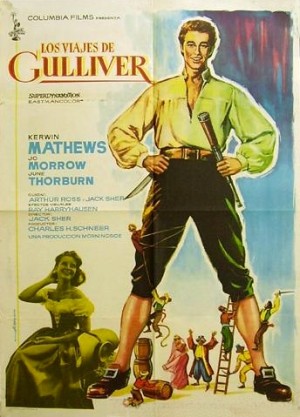 After the dark sonorities of Psycho, it was no doubt a relief for Herrmann to be able to cleanse his palate with a lighter confection. Just four days after signing off the Hitchcock score (dated 12th February 1960), Herrmann picked up his pencil and started sketching ideas for The Three Worlds of Gulliver. The film – the second collaboration with Ray Harryhausen and Charles Schneer – was not so much an adaptation of Jonathan Swift’s famous satire as a liberal reworking of its lighter themes. It gave Herrmann the opportunity to write in his beloved 18th century idiom (“Overture”, Minuetto”, and “A Hatful of Fish”). He also served up several delightful courses of toy marches and fanfares for the Lilliputians (“The King’s March”and “Naval Battle”) together with gargantuan portions of contrabass tuba for the Brobdingnags.
After the dark sonorities of Psycho, it was no doubt a relief for Herrmann to be able to cleanse his palate with a lighter confection. Just four days after signing off the Hitchcock score (dated 12th February 1960), Herrmann picked up his pencil and started sketching ideas for The Three Worlds of Gulliver. The film – the second collaboration with Ray Harryhausen and Charles Schneer – was not so much an adaptation of Jonathan Swift’s famous satire as a liberal reworking of its lighter themes. It gave Herrmann the opportunity to write in his beloved 18th century idiom (“Overture”, Minuetto”, and “A Hatful of Fish”). He also served up several delightful courses of toy marches and fanfares for the Lilliputians (“The King’s March”and “Naval Battle”) together with gargantuan portions of contrabass tuba for the Brobdingnags.
The score is by its very nature something of a hodge-podge of styles, but it’s never anything less than delightful. Herrmann recorded sections of the score for his Decca album The Mysterious Film World of Bernard Herrmann. The full soundtrack – re-recorded by the ever-faithful Joel McNeely – is available on Varese Sarabande (VSD-6162). Right now I’m listening to the mid section of “Naval Battle”, which has some self-borrowing from On Dangerous Ground.
Mysterious Island
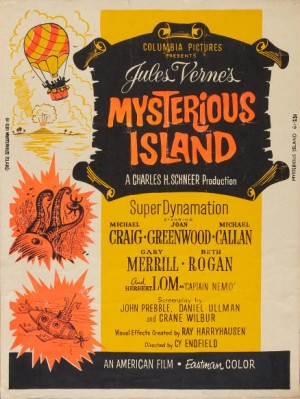 Mysterious Island, another Schneer/Harryhausen production, was very loosely based on Jules Verne’s novel of adventure The Mysterious Island (L’Île mystérieuse in the original French). In the transition to the big screen a lot more than the definite article was lost – unsurprising, considering that the book runs to over seven hundred pages in its unexpurgated form. Being a Ray Harryhausen picture, a lot had to be added in the form of marvellous creatures: a giant bee, an outsized crab, a prehistoric chicken and a mammoth octopus – all animated through the miracle of Dynamation. Herrmann’s music helped to bring these clay models to life, and his monumental piece “Escape to the Clouds”, which underscored a lengthy hot air balloon flight through a storm, was so Wagnerian in scale that it easily diverted attention from some obvious model work. Another set piece was the music for “The Giant Crab”, a crashing battle of horns, strings, wind and cymbals that imitated the spidery gait of the creature. A piece that manages to be terrifying and funny at the same time is “The Phorarhacos”, a madcap fugue that accompanies the appearance and slaying of a giant bird. For the underwater sequences featuring Captain Nemo (this time played by Herbert Lom with his ingenious conch shell breathing apparatus) Herrmann used the same techniques that had served him well on Beneath the Twelve Mile Reef. The cue titles I’ve given come from the Cloud Nine release of excerpts from the original soundtrack (ACN 7017). The complete score – at just over seventy minutes – is available on Tribute Film Classics (TFC-1001), and, as the catalogue number suggests, it was the label’s very first release.
Mysterious Island, another Schneer/Harryhausen production, was very loosely based on Jules Verne’s novel of adventure The Mysterious Island (L’Île mystérieuse in the original French). In the transition to the big screen a lot more than the definite article was lost – unsurprising, considering that the book runs to over seven hundred pages in its unexpurgated form. Being a Ray Harryhausen picture, a lot had to be added in the form of marvellous creatures: a giant bee, an outsized crab, a prehistoric chicken and a mammoth octopus – all animated through the miracle of Dynamation. Herrmann’s music helped to bring these clay models to life, and his monumental piece “Escape to the Clouds”, which underscored a lengthy hot air balloon flight through a storm, was so Wagnerian in scale that it easily diverted attention from some obvious model work. Another set piece was the music for “The Giant Crab”, a crashing battle of horns, strings, wind and cymbals that imitated the spidery gait of the creature. A piece that manages to be terrifying and funny at the same time is “The Phorarhacos”, a madcap fugue that accompanies the appearance and slaying of a giant bird. For the underwater sequences featuring Captain Nemo (this time played by Herbert Lom with his ingenious conch shell breathing apparatus) Herrmann used the same techniques that had served him well on Beneath the Twelve Mile Reef. The cue titles I’ve given come from the Cloud Nine release of excerpts from the original soundtrack (ACN 7017). The complete score – at just over seventy minutes – is available on Tribute Film Classics (TFC-1001), and, as the catalogue number suggests, it was the label’s very first release.
Tender is the Night
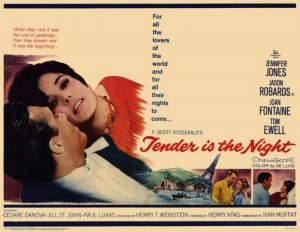 Tender is the Night is the last picture that Herrmann did at Fox, a studio with whom he had enjoyed a twenty year working relationship. When Alfred Newman retired as head of the studio’s music department in 1960, Herrmann lost a champion in a man who had not only appreciated his gifts as a composer but had been willing to tolerate his abrasive character. Newman was succeeded by his brother Lionel, who took a dim view of Herrmann’s compositional skills (“he couldn’t write a tune to save his ass” was his considered judgement). There was also a personality clash between the two men, although, to be fair, pretty much any personality would clash with Herrmann’s.
Tender is the Night is the last picture that Herrmann did at Fox, a studio with whom he had enjoyed a twenty year working relationship. When Alfred Newman retired as head of the studio’s music department in 1960, Herrmann lost a champion in a man who had not only appreciated his gifts as a composer but had been willing to tolerate his abrasive character. Newman was succeeded by his brother Lionel, who took a dim view of Herrmann’s compositional skills (“he couldn’t write a tune to save his ass” was his considered judgement). There was also a personality clash between the two men, although, to be fair, pretty much any personality would clash with Herrmann’s.
Herrmann turned down the job when he learnt that he would be required to incorporate the melodies of songwriting duo Sammy Fain and Paul Francis into his score. He soon relented, though, and snatched the commission from under the nose of his friend Lyn Murray to whom it had been reassigned. The two men never spoke to each other again, and it was a pattern that was to repeat itself in other Herrmann relationships as the composer became increasingly belligerent with age.
Herrmann’s behaviour does him no credit and, ironically, his desire to be associated with a prestigious studio project backfired when the film was greeted with universal indifference. The score he produced is a dreary one and I’m listening to it right now under duress. There are seventeen tracks (including the ghastly end credits song) on Bernard Herrmann at Fox Vol.1 (VSD-6052). It has its defenders. Stephen C. Smith, Herrmann’s biographer, calls it “eloquent” and claims it to be “one of the film’s few virtues.” I wouldn’t know about that. Not seen the film. Don’t want to.
Cape Fear
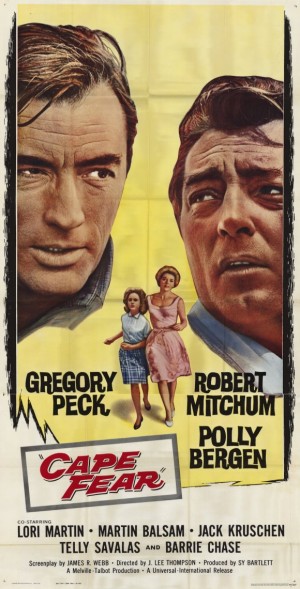 At the same time as he was writing music at Fox for the doomed Tender is the Night, Herrmann was working on Cape Fear for Universal (his only picture for that studio). A story of revenge and redemption it was based on a novel called The Executioners by hard-boiled crime writer John D. MacDonald. Robert Mitchum sneered menacingly in the role of Max Cady, an ex-con determined to get revenge on the lawyer who put him behind bars (Gregory Peck in his best Atticus Finch mode). Unable to protect his family through legal means, Peck’s character is forced to mete out his own form of brutal justice in a climax of savage violence.
At the same time as he was writing music at Fox for the doomed Tender is the Night, Herrmann was working on Cape Fear for Universal (his only picture for that studio). A story of revenge and redemption it was based on a novel called The Executioners by hard-boiled crime writer John D. MacDonald. Robert Mitchum sneered menacingly in the role of Max Cady, an ex-con determined to get revenge on the lawyer who put him behind bars (Gregory Peck in his best Atticus Finch mode). Unable to protect his family through legal means, Peck’s character is forced to mete out his own form of brutal justice in a climax of savage violence.
The film was directed by J.Lee Thompson, who had directed Peck in The Guns of Navarone the previous year. Thompson had been a last minute replacement on that film and, when he delivered a war movie classic that was also a box office smash, Hollywood came knocking. He had to fight a different kind of war on Cape Fear, battling against the censors over cuts. By today’s standards – or, indeed, in comparison with Martin Scorcese’s sadistic remake – the picture seems quite tame, but Herrmann’s brutal score still packs a punch.
The score opens with a savage statement for trombones that suggests the coiled reserves of anger and violence in Max Cady. Like Cady himself, the theme appears when least expected, rising up out of threatening dissonant strings that swirl through the movie like dark forceful currents. The music was reworked by Elmer Bernstein for the Scorcese remake, but did not really work the second time around. The fault was more to do with Scorcese’s lurid direction and Robert De Niro’s pantomime performance than anything else.
Right now I’m listening to the churning strings of the penultimate track (“The Struggle/The Rock/The Spike”) on the Tsunami release The Marvellous Film World of Bernard Herrmann (TCI 0605).
Jason and the Argonauts
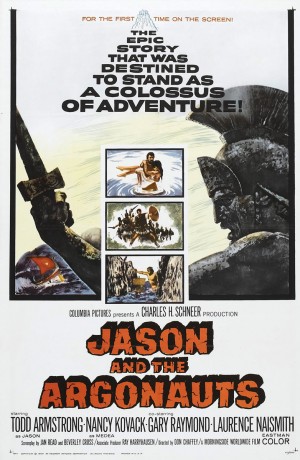 Jason and the Argonauts was the the last film on which Herrmann collaborated with Charles Schneer and Ray Harryhausen. Although each production was more lavish than the last, Herrmann resented the producer’s parsimonious attitude towards the music budget. In fact, with the score for Jason, he seemed to be almost testing the limits of what he would be allowed to do, writing music that required an augmented orchestra of wind and brass with no fewer than thirty six percussion players and a range of instruments that included the gockenspiel, xylophones, tambourines, woodblocks and a triangle.
Jason and the Argonauts was the the last film on which Herrmann collaborated with Charles Schneer and Ray Harryhausen. Although each production was more lavish than the last, Herrmann resented the producer’s parsimonious attitude towards the music budget. In fact, with the score for Jason, he seemed to be almost testing the limits of what he would be allowed to do, writing music that required an augmented orchestra of wind and brass with no fewer than thirty six percussion players and a range of instruments that included the gockenspiel, xylophones, tambourines, woodblocks and a triangle.
Harryhausen and Schneer would go on to make more movies (including The Valley of the Gwangi and the original Clash of the Titans), but, alas, without Herrmann. At least, with Jason, their working relationship ended on a bang and not a whimper.
Essentially, the film was a men-on-a-mission story dressed up in togas and sandals. Fearless warrior Jason (Todd Armstrong) collects a band of like-minded brothers to help him find the fabled golden fleece that will somehow help him overthrow his father’s murderer Pelias from the usurped throne of Thessaly. On the way he is aided by the goddess Hera (Honor Blackman) and abetted by Acastus (Gary Raymond), who is the son of Pelias and has been ordered to sabotage the voyage. None of this elaborate plotting mattered, of course, because what people really wanted to see were the latest Harryhausen creations.
The master of Dynamination did not disappoint. There was the giant bronze statue of Talos that creaked into life when two foolish Argonauts attempted to steal some treasure. There were winged harpies that tormented a blind Patrick Troughton. There was a bare chested Triton with a merman’s tail, and a hissing many-headed Hydra. And, best of all, there was an army of sword-wielding skeletons. For Talos, Herrmann turned the dial all the way up to eleven with a pounding four-note figure. The cue “The Attack/Talos’ Heel/Talos’ Death” will not only rattle your speakers but your back teeth as well. For the fight with the skeletons there is a cue called “Scherzo Macabre” which – amidst a battery of almost every item of percussion known to man – employs the same xylophone technique that was used in The Seventh Voyage of Sinbad. For the Argo itself (an impressive full scale model) Herrmann wrote a noble stately march that suggested the power of the ship under full oar.
The full score is available on a re-recording by Bruce Broughton on the Intrada label (MAF7083), and among Herrmann afficiandos it is considered to be one of the best.
The Birds
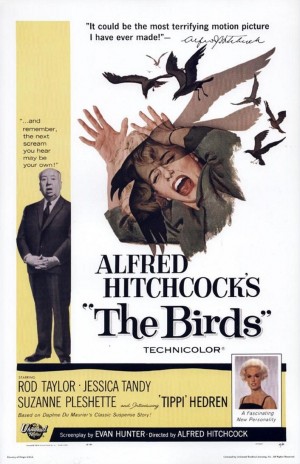 Early on in production Hitchcock decided that The Birds would have no conventional music score, and so on the final picture Herrmann is credited as Sound Consultant. This meant working with Oskar Sala and Remi Gassmann who were experts on the electro-acoustic Trautonium. The croaks and cries of the birds that punctuate the latter part of the film were created on the machine by Oskar Sala in West Berlin. Even some of the film’s silences were electronic manipulations. Hitchcock knew the importance of music in cinema and, in particular, the importance of music in his own films, but for him a film score wasn’t music per se but another element of the overall sound design. It’s surprising, given the views Herrmann expressed in interviews, that the composer should agree with his director. “Very few films can dispense with [music] altogether,” he said. The Birds was a bold aural experiment, but there’s a part of me that wishes Herrmann had written music for the picture.
Early on in production Hitchcock decided that The Birds would have no conventional music score, and so on the final picture Herrmann is credited as Sound Consultant. This meant working with Oskar Sala and Remi Gassmann who were experts on the electro-acoustic Trautonium. The croaks and cries of the birds that punctuate the latter part of the film were created on the machine by Oskar Sala in West Berlin. Even some of the film’s silences were electronic manipulations. Hitchcock knew the importance of music in cinema and, in particular, the importance of music in his own films, but for him a film score wasn’t music per se but another element of the overall sound design. It’s surprising, given the views Herrmann expressed in interviews, that the composer should agree with his director. “Very few films can dispense with [music] altogether,” he said. The Birds was a bold aural experiment, but there’s a part of me that wishes Herrmann had written music for the picture.
In the year that The Birds was released Herrmann started work on another Hitchcock project, but this time for the small screen. From 1963 to 1965 he scored seventeen episodes of The Alfred Hitchcock Hour, a total of about five hours of music. The director’s cameo appearances in his own films had made his portly profile famous all over the world, but it was television that turned him into a celebrity. His lugubrious delivery of the blackly comic introductions to Alfred Hitchcock Presents and The Alfred Hitchcock Hour cemented his on-screen persona in the public imagination. Like the fat boy in The Pickwick Papers he delighted in making the flesh creep.
Until now, the music that Herrmann wrote for Hitchcock’s TV shows has been unavailable on disc. To coincide the the 100th anniversary of the composer’s birth Varese Sarabande have released the first of a projected two volume set (VCL 0511 1119). My copy arrived in the post just six days ago, and I’ve put off listening to it until now. The music is playful, suspenseful, lyrical, macabre, and, above all, fresh.
Marnie
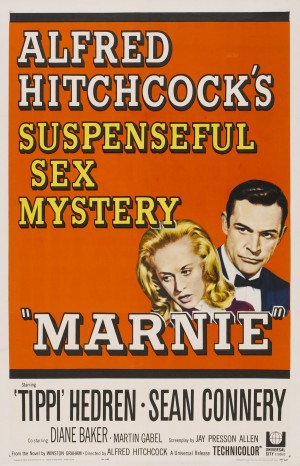 Although Herrmann could not know it when he embarked on the score for Marnie in January 1964, it was to be the last he would complete for Alfred Hitchcock. Although the professional collaboration between the director and the composer was less than a decade old, it was beginning to show signs of strain. While Hitchcock was at least trying to keep up with the changing times, Herrmann seemed to be becoming more and more reactionary, and it could only be a matter of time before the two locked horns.
Although Herrmann could not know it when he embarked on the score for Marnie in January 1964, it was to be the last he would complete for Alfred Hitchcock. Although the professional collaboration between the director and the composer was less than a decade old, it was beginning to show signs of strain. While Hitchcock was at least trying to keep up with the changing times, Herrmann seemed to be becoming more and more reactionary, and it could only be a matter of time before the two locked horns.
Hitchcock’s reputation as a filmmaker was secure. The Birds had been shown out of competition at the Cannes Film Festival and had been given a gala screening at the Museum of Modern Art in New York as part of a fifty film retrospective of his work. Francois Truffant had interviewed him with the help of an interpreter over fifty hours in preparation for a book that, when it was published in 1966, would confer on Hitchcock the status of ultimate auteur. The director may have been an artist first, but he was also a businessman, and he always kept a keen eye on the money. Securing Sean Connery for the male lead of his next film would seem likely to assure its box-office success, but he was frustrated in his attempts to woo Grace Kelly (now Princess Grace of Monaco) back onto the screen.
The reason for Princess Grace’s reluctance to step back into the Hollywood spotlight was the material that Hitchcock was proposing for his next feature. Marnie, based on a novel by Winston Graham, was the story of a frigid kleptomaniac who is raped by her husband. Her sexual hang-ups stem from a childhood incident when she bludgeoned a man to death with a poker in an attempt to protect his prostitute mother. And, if that were not enough, she also kills a horse. Rather than playing down the racy material, Hitchcock – desperate to appeal to the liberated Sixties audiences – wanted to lay it bare, and he ultimately fell out with scriptwriter Evan Hunter (aka Ed McBain) over the crucial rape scene.
At least the director was confident he could control his female lead (‘Tippi’ Hedren) – after all he had discovered her, and – just like Scottie Ferguson with Judy – had been grooming her for a very special role. But during the shooting Hitchcock and Hedren fell out. He would later claim that she had done something no one was permitted to do – refer to his weight. Her side of the story, which only came out after the director’s death, was that he had sexually harrassed her. “All I can say,” she told one interviewer demurely, “is demands of me were made that I couldn’t acquiesce to.” The rift was irrevocable. The two never worked together again and, cruelly, Hitchcock used the terms of Hedren’s contract to deny her a career.
Apologists for Marnie say that Hitchcock deliberately sabotaged his own film with poor rear projection and slipshod backdrops to get back at his star, or that these suspect elements of the film were placed deliberately to highlight the artifice of his construct. Whether it was accident or design or just pure sloppiness, I don’t know, but I still find Marnie a strangely affecting experience every time I watch it.
Herrmann’s score conveys the picture’s mood of suppressed hysterial in musical form. The love theme – for want of a better phrase – is more tortured than tender, and its constant repetition (without much variation) through the film mirrors Marnie’s compulsive behaviour.
The film was not a success – not even Sean Connery could draw the crowds – and suddenly Hitchcock was in danger of becoming yesterday’s man, and started looking round for people to blame. It would only be a matter of time before he found a scapegoat in Herrmann.
The Marnie score is available on Varese Sarabande (VSD-6094). A suite of the music – which includes the spirited “The Hunt” cue – has been recorded on several occasions.
Joy in the Morning
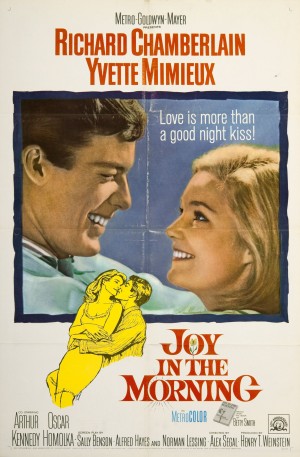 Herrmann’s only score of 1965 was Joy in the Morning, a joyless adaptation of a Betty Smith novel about marriage in Brooklyn. The movie seems to have left Herrmann uninspired and the music he provided was a shameless retread of the material he had written for Hitchcock the previous year. In fact, so similar was the main theme that Hitchcock (always with an eye on the money) wondered whether he might have some claim on the music rights. On November 4th he sent a lengthy telegram to Herrmann, who had by then decamped to London. The director began by reiterating his desire for his regular composer to score his planned espionage thriller, but then launched into a long lecture on the responsibilities of the artist:
Herrmann’s only score of 1965 was Joy in the Morning, a joyless adaptation of a Betty Smith novel about marriage in Brooklyn. The movie seems to have left Herrmann uninspired and the music he provided was a shameless retread of the material he had written for Hitchcock the previous year. In fact, so similar was the main theme that Hitchcock (always with an eye on the money) wondered whether he might have some claim on the music rights. On November 4th he sent a lengthy telegram to Herrmann, who had by then decamped to London. The director began by reiterating his desire for his regular composer to score his planned espionage thriller, but then launched into a long lecture on the responsibilities of the artist:
I AM VERY ANXIOUS FOR YOU TO DO THE MUSIC ON TORN CURTAIN STOP I WAS EXTREMELY DISAPPOINTED WHEN I HEARD THE SCORE OF JOY IN THE MORNING NOT ONLY DID I FIND IT CONFORMING TO THE OLD PATTERN BUT EXTREMELY REMINISCENT OF THE MARNIE MUSIC IN FACT THE THEME WAS ALMOST THE SAME STOP UNFORTUNATELY FOR WE ARTISTS WE DO NOT HAVE THE FREEDOM THAT WE WOULD LIKE TO HAVE BECAUSE WE ARE CATERING TO AN AUDIENCE AND THAT IS WHY YOU GET YOUR MONEY AND I GET MINE STOP
What Hitchcock probably didn’t know was that the music for Marnie was already second-hand by the time he acquired it. Herrmann had used the string melody as the theme for the Princess in The Seventh Voyage of Sinbad. So, if it had gone to court, the Master of Suspense could have ended up owing money to Ray Harryhausen.
Joy in the Morning is, surprisingly, available on disc on an FSM release (Vol. 5 No. 3). In a way, it’s testament to Herrmann’s reputation that even his weakest most derivative scores are available on CD. I don’t own the score and have never heard it. Still, if Hitchcock says it sounds like Marnie, who am I to argue?
Torn Curtain
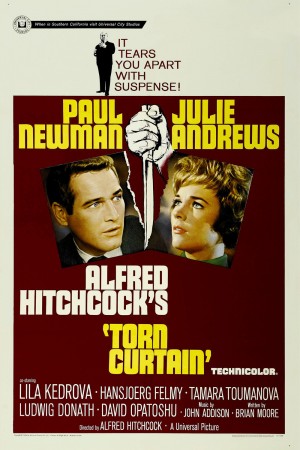 The spy thriller was a type of picture that Hitchcock could rightly claim as his own by the end of the Fifties – after all, wasn’t North by Northwest (with its beautiful women, famous landmarks, and hair-raising stunts) the prototype of a genre that would dominate the Sixties? Throughout that decade James Bond, Derek Flint, Matt Helm, Napoleon Solo and Illya Kuryakin were regularly dispatched on missions to rid the world of evil megalomaniacs bent on world domination. In Torn Curtain Hitchcock wanted to debunk the glamorous myth of espionage that he had helped to create – he had made the mould, and, now with his fiftieth film, he wanted to break it.
The spy thriller was a type of picture that Hitchcock could rightly claim as his own by the end of the Fifties – after all, wasn’t North by Northwest (with its beautiful women, famous landmarks, and hair-raising stunts) the prototype of a genre that would dominate the Sixties? Throughout that decade James Bond, Derek Flint, Matt Helm, Napoleon Solo and Illya Kuryakin were regularly dispatched on missions to rid the world of evil megalomaniacs bent on world domination. In Torn Curtain Hitchcock wanted to debunk the glamorous myth of espionage that he had helped to create – he had made the mould, and, now with his fiftieth film, he wanted to break it.
The film told the story of an American scientist (Paul Newman) who defects to East Germany as a cover in order to learn a secret formula from his old professor. He is pursued by his fiancee (Julie Andrews), who is torn between her love for him and her love for her country. On release the film was met with almost universal derision: “awful”, “preposterous” and “irritatingly slack” were some of the choice adjectives in The New Yorker review. Life magazine’s film critic Richard Schickel spoke for many when he said, “Hitchcock is tired to the point where what once seemed highly personal style is now merely repetition of past triumphs.” In fact, Hitchcock had levelled this very same criticism at Herrmann in a telegram date November 4, 1965. He accused the composer of “conforming to the old pattern” and asked for something new, something with “a beat and a rhythm” that would satisfy the demands of the “young, vigorous and demanding” young audiences. He went on:
…I AM ASKING YOU TO APPROACH THIS PROBLEM WITH A RECEPTIVE AND IF POSSIBLE ENTHUSIASTIC MIND. IF YOU CANNOT DO THIS THEN I AM THE LOSER. I HAVE MADE UP MY MIND THAT THIS APPROACH TO THE MUSIC IS EXTREMELY ESSENTIAL, I ALSO HAVE VERY DEFINITE IDEAS AS TO WHERE MUSIC SHOULD GO IN THE PICTURE AND THERE IS NOT TOO MUCH.
Herrmann replied the very next day with what looked like an acceptance of Hitchcock’s terms. With hindsight, however, it’s difficult not to detect an element of irony in the composer’s tone:
DELIGHTED COMPOSE VIGOROUS BEAT SCORE FOR TORN CURTAIN ALWAYS PLEASED HAVE YOUR VIEWS REGARDING MUSIC FOR YOUR FILM
In referring to rhythm and beat it’s quite possible that Hitchcock had in mind the scores of John Barry, who was providing propulsive music for the James Bond series and managing to knock out hit songs for each movie as well. There hadn’t been a hit song for a Hitchcock picture since The Man Who Knew Too Much. To Herrmann a “vigorous beat score” would mean a thundering timpani section. Had the two men sat down face to face, they might have worked out the misunderstandings between them, but, with Herrmann writing in London and Hitchcock holed up in his wood-panelled office at Universal, there was no chance of an early agreement.
Herrmann arrived in Los Angeles just after Christmas and played some early sketches (not yet orchestrated) for the director, who immediately pronounced them to be too “heavy”. Hitchcock also took the opportunity to remind Herrmann that he wanted no music under the lengthy killing of the secret policeman Gromek. The director rightly saw this as the movie’s set piece – the moment that, like the Psycho shower scene, would grab the audience’s attention, and be talked about and analysed for its virtuoso technique. Herrmann had heard all this before on Psycho. In going against the director’s express wishes on that occasion, he had proved himself to be right, and had been handsomely rewarded in the process.
Again, the opportunity for the two men to iron out their differences was lost. Herrmann finished the score within a couple of months. When he stood before the bizarre orchestra of brass and woodwinds at the Goldwyn Studios in March 1966 and raised his baton to conduct the “Prelude”, he had no idea that his professional career was about to implode. Hitchcock came by the recording studio to listen to the day’s work. “I heard the first segment,” he said, “and I said, ‘Finished, no other way, finished; goodbye, here’s your money, sorry.’ ” Not being a man who enjoyed confrontation, Hitchcock then walked out of the studio. Years later, when Herrmann came by his office to attempt a kind of reconciliation, the director hid behind his door and instructed his secretary to say that he was out.
John Addison, who had won an Oscar for his score to Tom Jones, came on board as a replacement for Herrmann. Under the difficult circumstances of a tight deadline, he produced a serviceable score, but it had none of the beat or rhythm that Hitchcock had originally called for. Herrmann ended up cannibalising parts of his unused score for The Battle of Neretva five years later.
The unused score finally emerged on CD in 1998 when Joel McNeely recorded it for Varese Sarabande (VSD-5817). It’s quite a grim affair, in keeping with the desaturated look of Hitchcock’s visuals. It opens with the thundering “Prelude” with its screaming flutes and blaring trombones, but consists mostly of low-key mood music. The stand-out moment in the score is the one piece of music Hitchcock did not ask for (“The Killing”). On the Torn Curtain DVD there is an extra feature that shows the sequence with Herrmann’s music. I agree with Hitchcock, though. The scene works better without music.The need for the killing to be done silently is an important plot point and a blaring orchestra accompaniment undermines the tension.
Fahrenheit 451
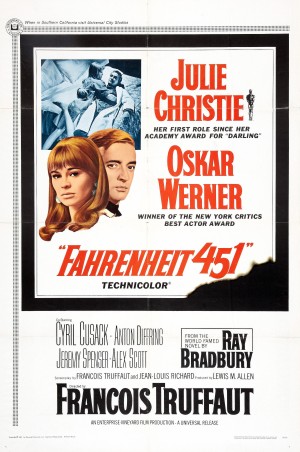 In November 1965 Herrmann signed off a letter to Hitchcock’s longtime assistant Peggy Robertson with news of a new project: “I have been asked to do Truffaut’s new film next May or June. I am certain that this is because of Hitch and I thank him for it.” The film was Fahrenheit 451, an adaptation of Ray Bradbury’s dystopian view of a world where the printed word is outlawed. Truffaut asked Herrmann to “give [him] music of the twenty first century”, but what he got was something timeless. The composer wrote for strings only and augmented the sound with harp, xylophone, vibraphone, marimba and glockenspiel. The lush strings are overlaid with trembling tender percussion, and some of the cues remind me of the seventh movement of Saint Saens’ “The Carnival of the Animals”.
In November 1965 Herrmann signed off a letter to Hitchcock’s longtime assistant Peggy Robertson with news of a new project: “I have been asked to do Truffaut’s new film next May or June. I am certain that this is because of Hitch and I thank him for it.” The film was Fahrenheit 451, an adaptation of Ray Bradbury’s dystopian view of a world where the printed word is outlawed. Truffaut asked Herrmann to “give [him] music of the twenty first century”, but what he got was something timeless. The composer wrote for strings only and augmented the sound with harp, xylophone, vibraphone, marimba and glockenspiel. The lush strings are overlaid with trembling tender percussion, and some of the cues remind me of the seventh movement of Saint Saens’ “The Carnival of the Animals”.
The film tells the story of Montag (Oskar Werner), a ‘fireman’ employed by the state in the task of book-burning. When he falls in love with bibliophile Clarissa (Julie Christie) he begins to question his role as an oppressor and seeks out a new way of life. The film’s visuals (flying jetpacks and monorails) have dated badly and Truffaut was never really confortable working in a genre idiom. The picture’s message seems forced and the sharp satire of Ray Bradbury’s original work is blunted by an over-literal interpretation. Nevertheless, there are two sublime moments, both of which are enhanced by Herrmann’s lustrous score. The first is the burning of Montag’s books cruelly documented to the sound of the shimmering “Flowers of Fire” cue. [Herrmann might have got a malicious thrill of pleasure seeing Robin Wood's Hitchcock's Films among the books consumed by flames.] The second is the final shot of the Book People walking in the snow while reciting the texts they have learnt by heart – this scene, which was filmed outdoors at Pinewood Studios, was a happy accident with Truffaut taking advantage of a real snowstorm.
Herrmann’s full score is available in a lush re-recording by Morgan and Stromberg on the Tribute Film Classics label (TFC-002). Herrmann arranged and recorded a Suite for Strings, Harp and Percussion from the film for one of his Decca albums, and this same suite has also been re-recorded by Joel MacNeely and Esa-Pekka Salonen.
The Bride Wore Black
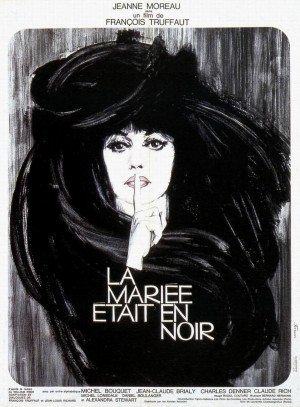 Despite the language barrier (or, perhaps, because of it) Herrmann and Truffaut got on well enough during the making of Fahrenheit 451 to agree to collaborate on a second project in 1967. The Bride Wore Black, or La Mariée était en noir in the language in which the film was made, was Trauffaut’s failed attempt to emulate the Master of Suspense. Based on a short story by Cornell Woolrich (author of the source material for Rear Window), it told the story of a young bride who takes revenge on the men who made her a widow on her wedding day. (A similar plot, coincidentally, to Quentin Tarantino’s Kill Bill Volume 1 and 2, which appropriated Herrmann’s psychotic whistling theme from Twisted Nerve.) The film did not live up to the promise of its premise. In the hands of Claude Chabrol it might have bloomed into a macabre oddity, but under Truffaut’s fussy care it withered on the vine. The critics hated it and even the director would later disown it.
Despite the language barrier (or, perhaps, because of it) Herrmann and Truffaut got on well enough during the making of Fahrenheit 451 to agree to collaborate on a second project in 1967. The Bride Wore Black, or La Mariée était en noir in the language in which the film was made, was Trauffaut’s failed attempt to emulate the Master of Suspense. Based on a short story by Cornell Woolrich (author of the source material for Rear Window), it told the story of a young bride who takes revenge on the men who made her a widow on her wedding day. (A similar plot, coincidentally, to Quentin Tarantino’s Kill Bill Volume 1 and 2, which appropriated Herrmann’s psychotic whistling theme from Twisted Nerve.) The film did not live up to the promise of its premise. In the hands of Claude Chabrol it might have bloomed into a macabre oddity, but under Truffaut’s fussy care it withered on the vine. The critics hated it and even the director would later disown it.
Herrmann build his score around a mordant version of Mendelssohn’s “Wedding March”, interpolating it into his own jagged sequences of horns and percussion. There were echoes of the music from On Dangerous Ground and – appropriately for a Gallic setting – a reworking of the “Memory Waltz” from The Snows of Kilimanjaro. Herrmann’s experience on the film was not a happy one. The score was recorded in Paris with a French orchestra with whom Herrmann struggled to communicate. Truffaut outwardly expressed delight at the finished result, but chopped and changed some of the cues in the editing without consulting the composer. He was, at least, gracious enough to send the composer a thank you note in bad English (“Francois Truffaut is very happy man … and he say thank you very very much for you and Norma your inspiratrice.”). Norma – Herrmann’s inspiration – was Norma Shepherd, Herrmann’s young bride, almost thirty years his junior.
There are eleven minutes and twenty seven seconds of the score in the form of “A Musical Scenario” on the Elmer Bernstein The Bernard Herrmann Film Score Tribute disc (Milan 71000-2), which I’ve been playing on a loop while writing the above.
Twisted Nerve
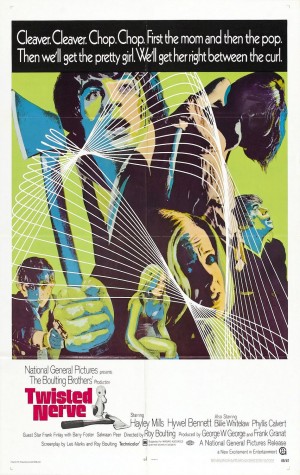 Unlike his contemporary Miklós Rózsa, who in the latter part of his career selected the projects he worked on with great care, Herrmann became less and less particular in his final years. Just as his famous first collaborator Orson Welles was prostituting his talent during the late Sixties in movies like Casino Royale and I’ll Never Forget What’s Isname, so Herrmann seemed to be slumming it. Had it not been for the last hurrah of Obsession and Taxi Driver, his career might have ended in a depressing muddle of low-rent horror films. The first of these was Twisted Nerve, a grubby English thriller about a disturbed young man (Hywel Bennett) with a disturbing infatuation for a young girl (Hayley Mills). The film’s suspect use of mental illness to explain away criminal actions provoked outrage and the film makers were forced to add a narrated disclaimer at the start of the film:
Unlike his contemporary Miklós Rózsa, who in the latter part of his career selected the projects he worked on with great care, Herrmann became less and less particular in his final years. Just as his famous first collaborator Orson Welles was prostituting his talent during the late Sixties in movies like Casino Royale and I’ll Never Forget What’s Isname, so Herrmann seemed to be slumming it. Had it not been for the last hurrah of Obsession and Taxi Driver, his career might have ended in a depressing muddle of low-rent horror films. The first of these was Twisted Nerve, a grubby English thriller about a disturbed young man (Hywel Bennett) with a disturbing infatuation for a young girl (Hayley Mills). The film’s suspect use of mental illness to explain away criminal actions provoked outrage and the film makers were forced to add a narrated disclaimer at the start of the film:
“Ladies and gentlemen, because of the controversy already aroused, the producers of this film wish to re-emphasize what is already stated in the film, that there is no established scientific connection between Mongolism and psychotic or criminal behavior.”
Defenders of the movie will tell you that it is in the grand British tradition of that other misunderstood masterpiece Peeping Tom when, in reality, it’s simply a precursor to the brutish nasty Seventies exploitation films of Pete Walker such as Frightmare and Schizo.
Herrmann struck on the novel idea of orchestrating the main theme for solo whistler accompanied by a queasy vibraphone and a brutal climax of horns. This whistling theme had a second life in Taranatino’s Kill Bill Volume 1 (Track 4 on the soundtrack, which I’m playing a loop right now), and on the back of that became a hip ringtone. A limited release of the score – coupled with The Bride Wore Black – was brought out by Kritzerland, but all 1,200 copies have been sold.
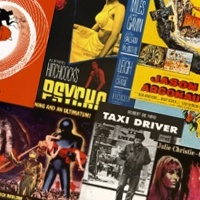

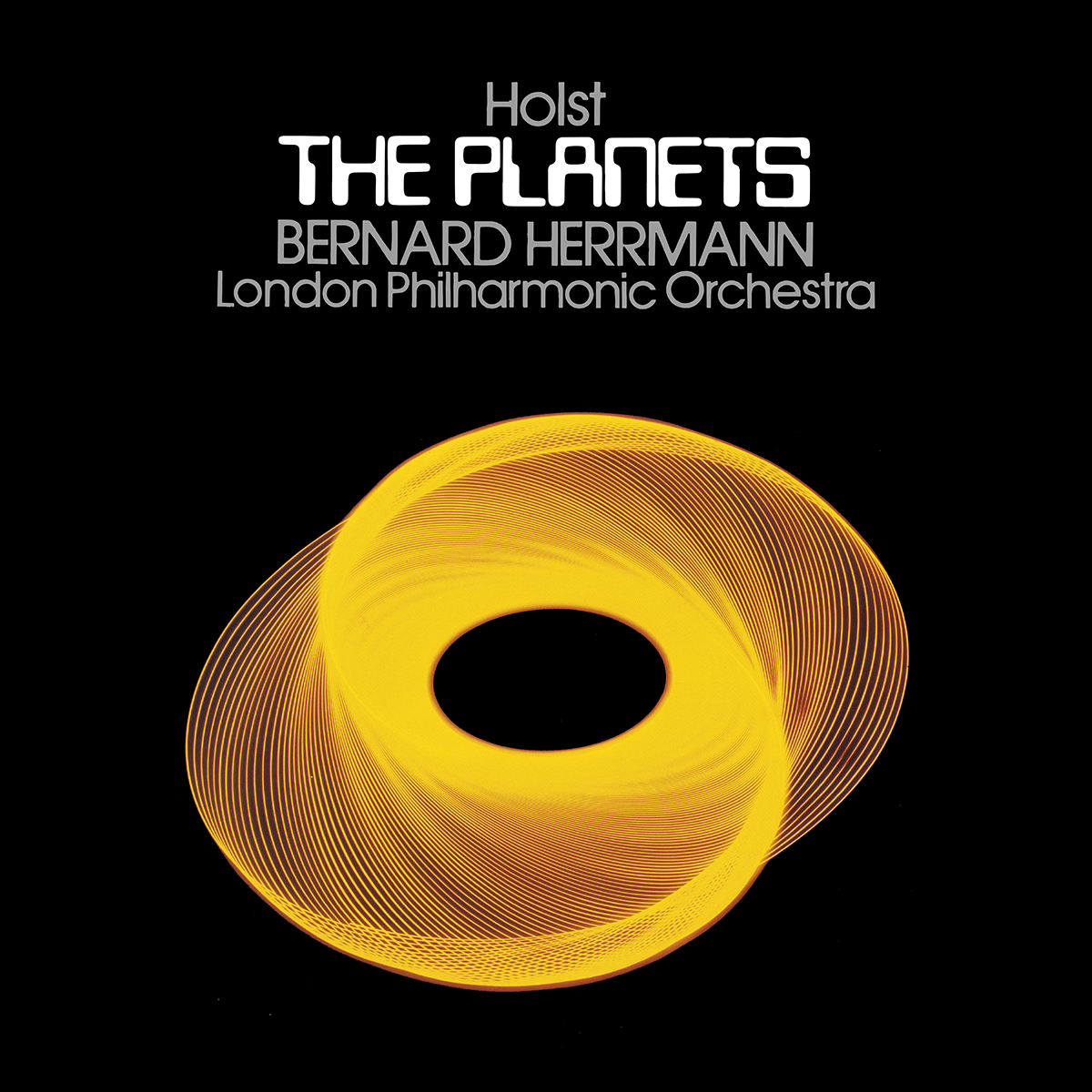
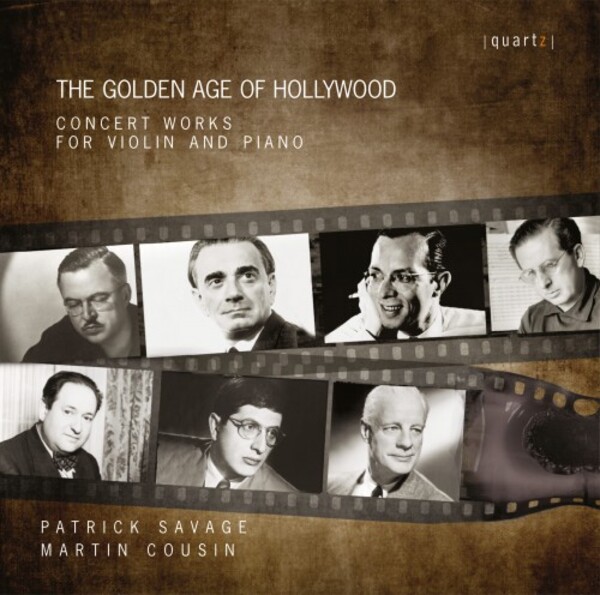
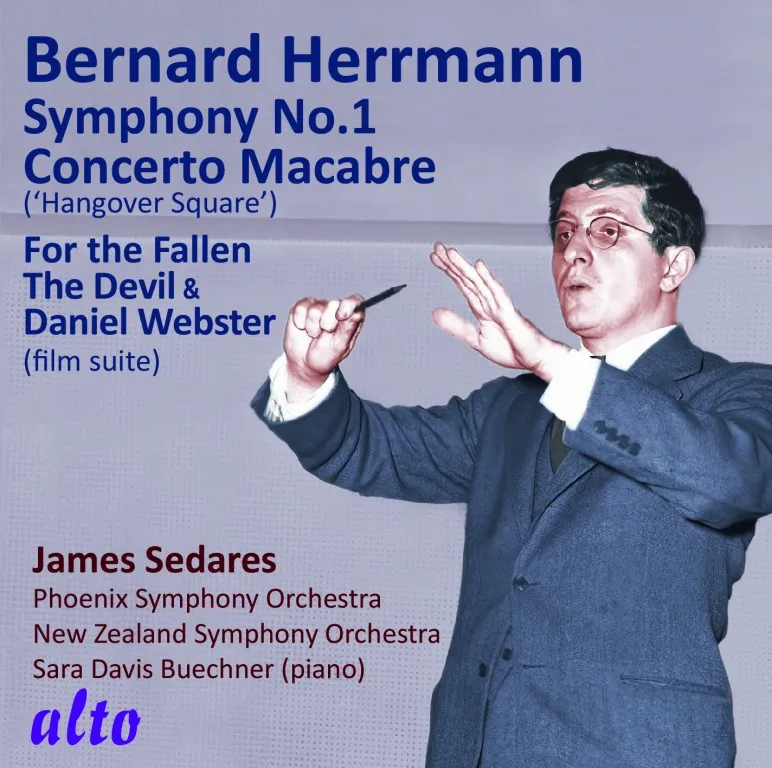
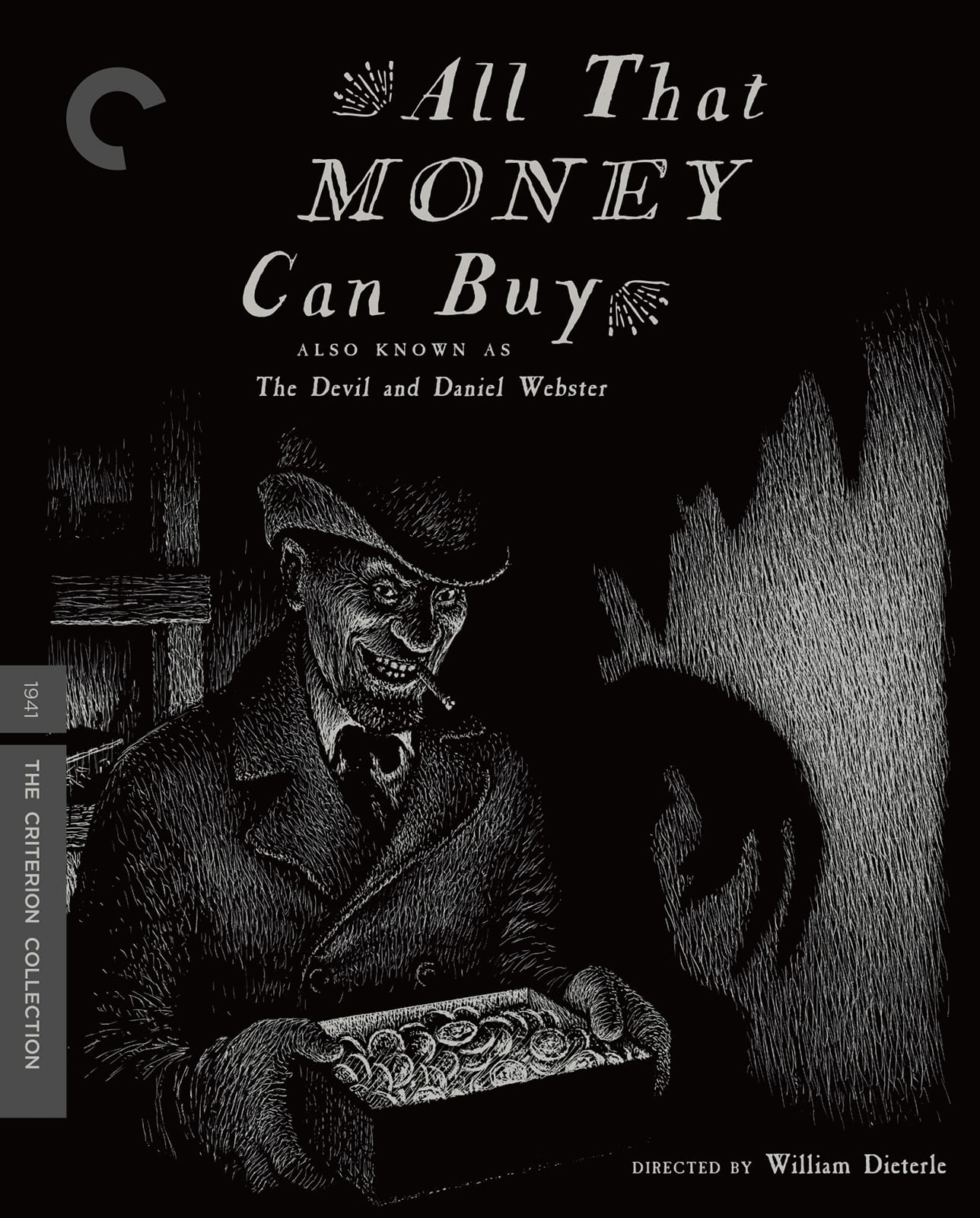
![The Man Who Knew Too Much – 4K restoration / Blu-ray [A]](http://www.bernardherrmann.org/wp-content/uploads/2023/11/TMWKTM-4K.jpeg)
![The Bride Wore Black / Blu-ray [B]](http://www.bernardherrmann.org/wp-content/uploads/2023/07/BrideWoreBlack.jpeg)
![Alfred Hitchcock Classics Collection / Blu-ray [A,B]](http://www.bernardherrmann.org/wp-content/uploads/2020/07/AHClassics1.jpg)
![Endless Night (US Blu-ray) / Blu-ray [A]](http://www.bernardherrmann.org/wp-content/uploads/2020/03/EndlessNightUS.jpg)
![Endless Night (UK Blu-ray) / Blu-ray [B]](http://www.bernardherrmann.org/wp-content/uploads/2019/12/ENightBluRay.jpg)